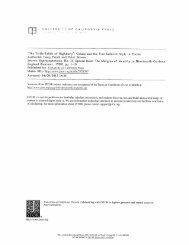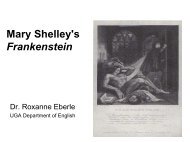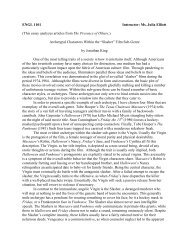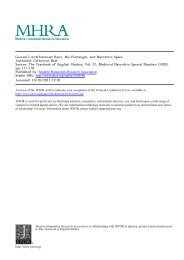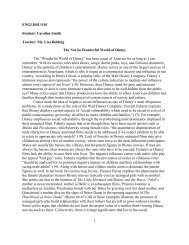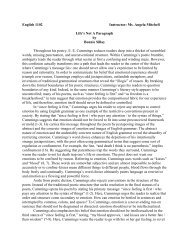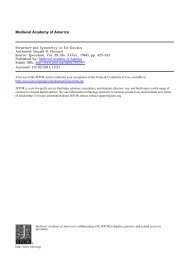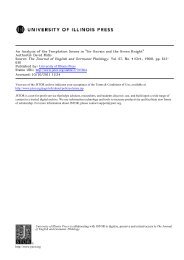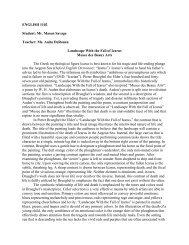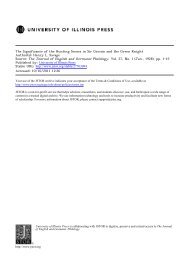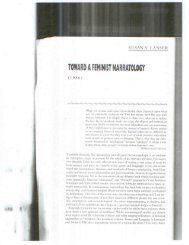Ms. Laura Thomas Teacher: Ms. Tina Venus - Department of English
Ms. Laura Thomas Teacher: Ms. Tina Venus - Department of English
Ms. Laura Thomas Teacher: Ms. Tina Venus - Department of English
Create successful ePaper yourself
Turn your PDF publications into a flip-book with our unique Google optimized e-Paper software.
ENGL1102<br />
Student: <strong>Ms</strong>. <strong>Laura</strong> <strong>Thomas</strong><br />
<strong>Teacher</strong>: <strong>Ms</strong>. <strong>Tina</strong> <strong>Venus</strong><br />
“False Façades in A Doll House”<br />
When a young girl plays with her doll house, she imagines a make-believe world<br />
full <strong>of</strong> enchantment. However, little does she realize the false and unattainable image <strong>of</strong><br />
perfection that lies before her. With every miniature doorway and elaborate bookcase, the<br />
doll house disguises reality with a mask <strong>of</strong> flawless excellence. Similarly, Henrik Ibsen<br />
describes many appearances in A Doll House as mere façades <strong>of</strong> deception. These images<br />
reiterate the theme that outer appearances are never what they seem. Through his dealing<br />
with Nora’s societal role and his use <strong>of</strong> symbolism, Ibsen effectively contrasts the themes<br />
<strong>of</strong> appearance and reality and suggests that all façades will eventually be revealed.<br />
In society’s view, the marriage between Nora and Torvald is a wonderful<br />
relationship. Torvald supports the family through his job at the bank while Nora is the<br />
caretaker for the children. However, they have no real communication between them.<br />
Torvald commonly refers to Nora as his “little lark” or “squirrel” (1010, 1012). He never<br />
treats Nora as an equal marital partner, much less an individual. In the end, the marriage<br />
has to end because <strong>of</strong> its lack <strong>of</strong> real communication. Thus, a source <strong>of</strong> deception in the<br />
play stems from the fact that the actual marriage between Nora and Torvald is not a<br />
healthy relationship, as in society’s view. Furthermore, when Nora decides to go against<br />
her husband’s will to borrow the money for the loan, she forsakes her matrimonial bond,<br />
yet gains personal independence. Nora considers the loan “something to be proud and<br />
happy for” (1017). Yet, in essence, she is pleased with her ability to lie to her husband.<br />
Through this circumstance, Ibsen successfully reveals that a relationship built on<br />
dishonesty cannot remain. In the end, the marital façade is revealed through Nora’s<br />
inability to remain in a relationship that, in her point <strong>of</strong> view, is not “a true marriage”<br />
(1061).<br />
Another form <strong>of</strong> deception in the play is Nora’s oscillating role between a<br />
homemaker and an individual. For Nora’s entire life, society has forced her to succumb to<br />
its expectations <strong>of</strong> a woman’s role as a devoted mother, rather than to her personal<br />
desires. However, in raising the children, she continues to reinforce these societal<br />
traditions. For example, Nora plays a game <strong>of</strong> hide-and-seek with her children. Although<br />
this amusement may seem infantile, the game itself is based on deception with its<br />
emphasis on concealment. Symbolically, Nora continues to hide behind the female<br />
persona <strong>of</strong> a mother. In the game, Nora replies, “Yes, let me hide first” (1023). As a<br />
mother, Nora sets the standards for her children. Thus, in essence, she is telling her<br />
children that it is acceptable to hide your true, individual desires. She therefore continues<br />
the repressive chain through the symbolic game <strong>of</strong> hide and seek, as she calls her children<br />
her “little, lovely doll babies” and encourages them in this entertainment (1023).<br />
However, Nora soon learns <strong>of</strong> Krogstad’s discovery <strong>of</strong> her forgery. She then<br />
recognizes that she cannot continue to conceal her past with a clear conscience. As a<br />
result, she never plays hide-and-seek with the children again, and, as a result,<br />
symbolically recognizes the fact that she “can’t be together with them as much as [she]<br />
was” (1031, original). She thus realizes that she must never visit with the children again
in order to break the societal tradition <strong>of</strong> individualistic repression. In the end, the<br />
motherly façade is revealed through Nora’s inability to pretend to care for the children.<br />
As a result, she departs from the household, leaving the children “in better hands than<br />
[her] own” (1060).<br />
Throughout the play, Ibsen employs recurring symbols to emphasize the role <strong>of</strong><br />
deception in A Doll House. The Christmas tree is a dominant figure <strong>of</strong> disguise that<br />
parallels Nora’s characterization in the play. In effect, the tree is a holiday decoration<br />
meant to add festive colors and beauty to the home. In the play, the tree parallels Nora’s<br />
role as a trophy wife for Torvald as he insists on her continual appearance as “[a] dream<br />
<strong>of</strong> loveliness” (1049). However, Ibsen soon reveals that images <strong>of</strong> perfection cannot<br />
endure. As Nora slowly recognizes Torvald’s impending discovery <strong>of</strong> the loan, the<br />
Christmas tree is described in the stage directions as “stripped <strong>of</strong> ornament, [with]<br />
burned-down candle stubs on its ragged branches” (1030). Along with this description,<br />
Nora also strips herself <strong>of</strong> her prior views and begins to understand her primary<br />
obligation to herself.<br />
Another source <strong>of</strong> deceitfulness originates from the concealment <strong>of</strong> the Christmas<br />
tree. When the tree is first brought to the house, Nora insists on hiding it so that her<br />
children will not “get a glimpse <strong>of</strong> it till [. . .] evening, after it’s trimmed” (1010).<br />
Similarly, Nora insists on concealing her Tarantella outfit until the night <strong>of</strong> the party. She<br />
tells Torvald, “No one can admire me in my splendor—not til tomorrow” (1043).<br />
Throughout the play, Torvald treats Nora like a plaything, a toy with which to entertain<br />
himself. Nora’s dancing <strong>of</strong> the Tarantella is the last time that she allows Torvald to treat<br />
her as his dancing doll, his “lovely little Capri girl” (1049). In the Tarantella costume, she<br />
is a possession <strong>of</strong> Torvald. Nora is only able to finally leave him after she changes into<br />
her regular clothes after the party. In essence, the Tarantella outfit represents her status<br />
as Torvald’s little doll and repressively masks her true desires for individualism. She thus<br />
deceives Torvald by adorning herself with the Tarantella costume.<br />
Furthermore, an additional source <strong>of</strong> deception in the play stems from the<br />
meaning <strong>of</strong> the Tarantella itself. The Tarantella is a customary ritual that is thought to<br />
purify the dancer <strong>of</strong> the poisonous bite <strong>of</strong> a tarantula. By dancing the Tarantella, Nora<br />
expresses her desire to cleanse herself <strong>of</strong> the repressive relationship with Torvald. As she<br />
“dances more and more wildly,” she symbolically expresses her independence (1044).<br />
However, the deception <strong>of</strong> the Tarantella comes from the fact that Torvald sees the<br />
Tarantella as a dance for his own pleasure. Although Nora has danced the Tarantella on<br />
previous occasions for Torvald, this Tarantella is very different. She does not follow his<br />
directions for the dance as he shouts at her to “[slow] down” (1044). Instead, she dances<br />
violently as “her hair loosens and falls over her shoulders” as she attempts to rid herself<br />
<strong>of</strong> Torvald’s grasp on her life (1044). Thus, Torvald and Nora view the Tarantella very<br />
differently. However, Torvald soon discovers the false façade <strong>of</strong> the Tarantella as Nora<br />
expresses her desire for individualism by leaving the marriage.<br />
Through his dealings with Nora’s role in society and his use <strong>of</strong> symbolism, Ibsen<br />
emphasizes in A Doll House that appearances are <strong>of</strong>ten deceiving. As Nora struggles with<br />
the façades in her life, she comes to the realization that she must leave her role as a<br />
housewife in order to gain “absolute freedom” (1060). Thus, Ibsen effectively portrays<br />
appearances as false because <strong>of</strong> Nora’s inability to remain in a relationship that represses<br />
her individualism. Through his ability to successfully expose deceiving façades, Ibsen
creatively provides insight into the unattainable images <strong>of</strong> society in his masterpiece, A<br />
Doll House.<br />
Works Cited<br />
Ibsen, Henrik. A Doll House. Trans. Rolf Fjelde. Making Literature Matter: An<br />
Anthology for Readers and Writers. 2 nd ed. Ed. John Schilb and John Clifford.<br />
Boston: Bedford, 2003. 1006-61.



